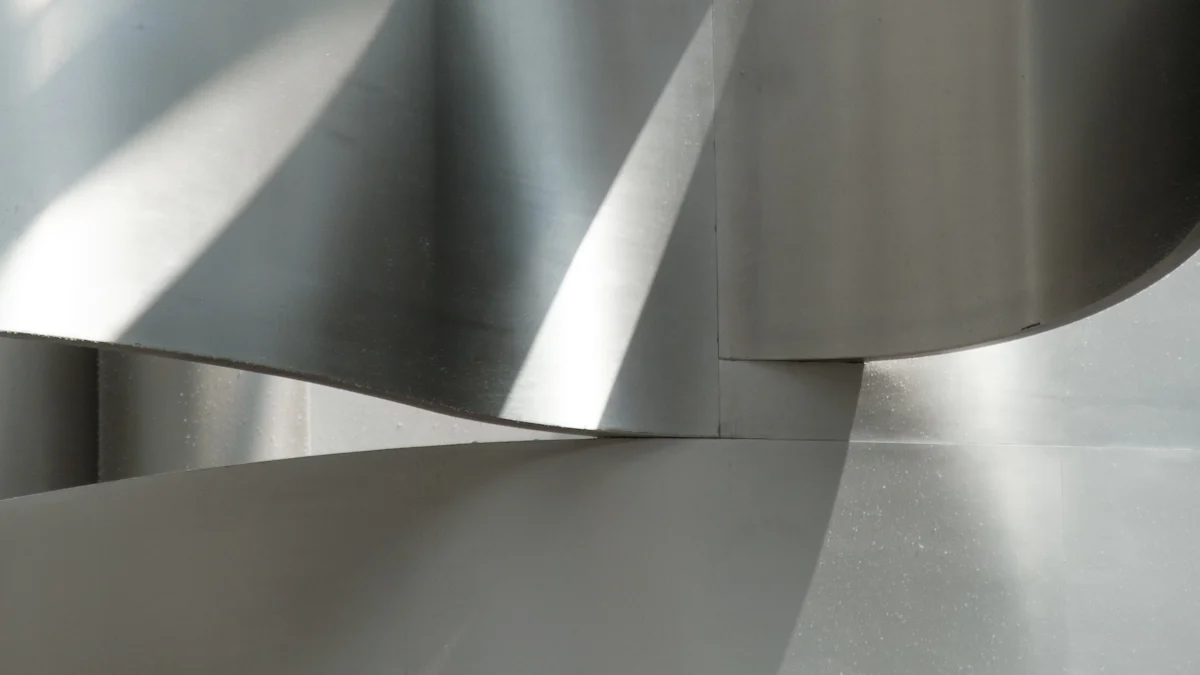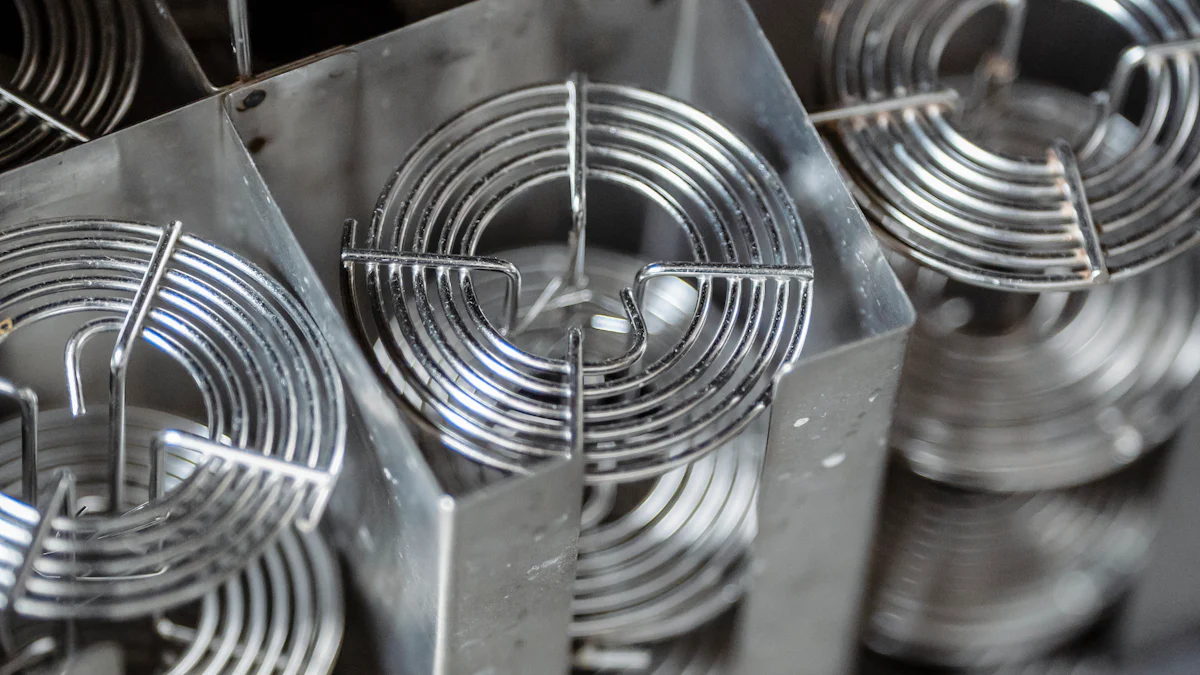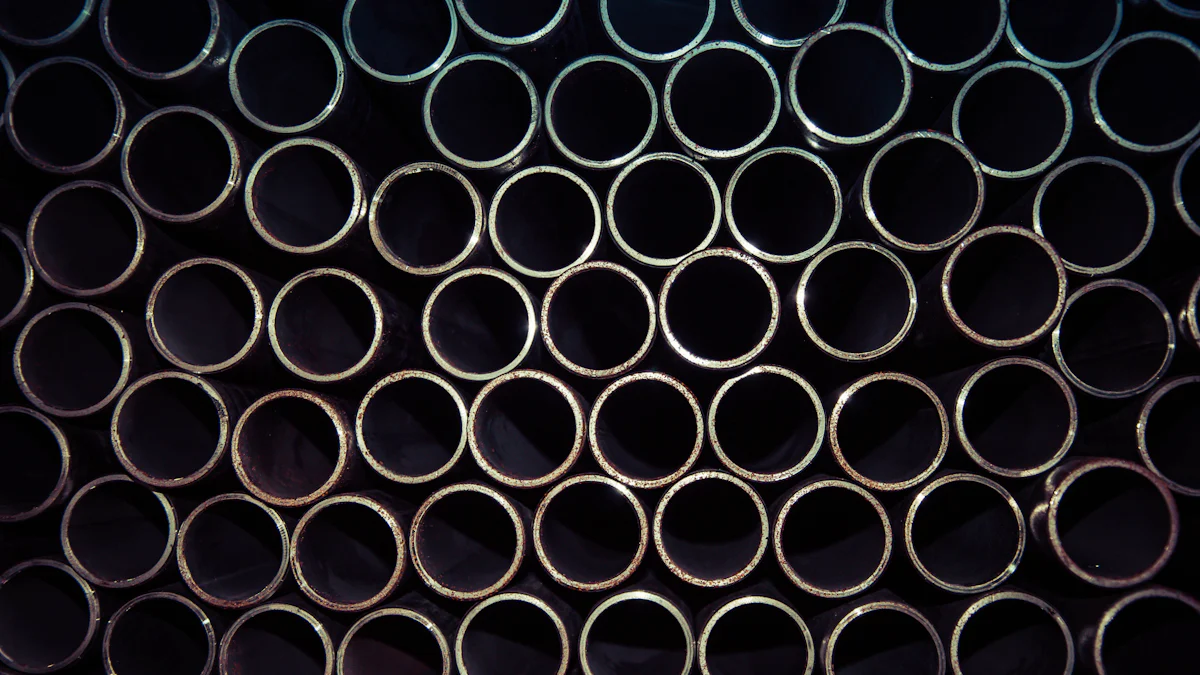
What is SUS 430 stainless steel? It’s a ferritic stainless steel known for its affordability and versatility. With approximately 18% chromium, this material forms a protective chromium oxide layer, enhancing its corrosion resistance. Its magnetic nature sets it apart from other stainless steels, making it suitable for various applications. The absence of nickel in its composition contributes to its cost-effectiveness, offering a budget-friendly option without compromising quality. This unique combination of properties makes SUS 430 stainless steel a popular choice in industries ranging from kitchen appliances to automotive parts.
Key Takeaways
- SUS 430 stainless steel is a cost-effective, ferritic stainless steel known for its affordability and versatility, making it suitable for various applications.
- With approximately 18% chromium, SUS 430 offers excellent corrosion resistance, particularly against organic acids, ensuring durability in various environments.
- The magnetic properties of SUS 430 stainless steel make it ideal for applications in industries like automotive and kitchen appliances, where magnetic components are beneficial.
- SUS 430’s good formability allows easy shaping and processing, making it a preferred choice for manufacturing complex components without compromising strength.
- While SUS 430 is cost-effective, its ferritic structure limits it in highly corrosive environments and presents challenges in welding.
- Understanding the chemical composition of SUS 430 helps appreciate its unique properties, including its strength, machinability, and thermal conductivity.
- SUS 430 stainless steel is widely used in kitchen appliances, automotive parts, and architectural applications, balancing quality and budget constraints effectively.
Chemical Composition of SUS 430 Stainless Steel

Understanding the chemical composition of SUS 430 stainless steel provides insight into its unique properties and applications. This ferritic stainless steel primarily consists of iron and chromium, with additional elements that enhance its performance.
Main Elements
Chromium content
Chromium plays a crucial role in the composition of SUS 430 stainless steel. It constitutes approximately 18% of the alloy. This significant chromium content forms a protective layer of chromium oxide on the surface, which enhances the material’s corrosion resistance. The presence of chromium also contributes to the steel’s ability to withstand oxidation, making it suitable for various environments.
Iron content
Iron serves as the base element in SUS 430 stainless steel, making up the majority of its composition. This element provides the structural backbone of the alloy, ensuring its strength and durability. The high iron content also contributes to the steel’s magnetic properties, distinguishing it from other non-magnetic stainless steels.
Additional Elements
Carbon
Carbon is present in small amounts in SUS 430 stainless steel. It typically ranges from 0.08% to 0.12%. This element influences the hardness and strength of the steel. However, excessive carbon can reduce corrosion resistance, so its content is carefully controlled.
Manganese
Manganese is another element found in SUS 430 stainless steel, usually in quantities up to 1%. It acts as a deoxidizer during the steelmaking process and improves the alloy’s strength and toughness. Manganese also enhances the steel’s machinability, making it easier to cut and shape.
Silicon
Silicon is present in SUS 430 stainless steel in small amounts, typically around 1%. It serves as a deoxidizing agent and helps improve the steel’s resistance to oxidation at high temperatures. Silicon also contributes to the overall strength and hardness of the alloy.
The combination of these elements results in a stainless steel that is both cost-effective and versatile. By understanding the chemical composition, one can appreciate why SUS 430 stainless steel is a popular choice for applications ranging from kitchen appliances to automotive parts.
Properties of SUS 430 Stainless Steel
Understanding the properties of SUS 430 stainless steel helps us appreciate its widespread use in various industries. This material’s unique characteristics make it a preferred choice for many applications.
Corrosion Resistance
SUS 430 stainless steel exhibits excellent corrosion resistance, particularly against organic acids and nitric acid. Its low carbon content plays a crucial role in preventing intergranular corrosion, which can occur when carbide precipitates at grain boundaries. This resistance ensures that the material maintains its mechanical properties even in corrosive environments. Additionally, SUS 430 stainless steel effectively resists stress corrosion cracking, making it suitable for applications where durability and longevity are essential.
Magnetism
One of the distinguishing features of SUS 430 stainless steel is its magnetic nature. This characteristic arises from its ferritic structure, which contrasts with the non-magnetic properties of austenitic stainless steels like 304. The magnetism of SUS 430 makes it ideal for applications where magnetic properties are required or where magnetic interference is not a concern. This feature is particularly valuable in industries such as automotive and kitchen appliances, where magnetic components are often necessary.
Formability
SUS 430 stainless steel offers good formability, allowing it to be easily shaped and processed into various forms. This property is crucial for manufacturing processes that involve rolling, bending, or stamping. The material’s moderate tensile strength and excellent machinability make it suitable for creating complex shapes without compromising structural integrity. Its formability, combined with its other properties, makes SUS 430 stainless steel a versatile material for a wide range of applications, from kitchenware to architectural components.
By exploring these properties, we gain a deeper understanding of what makes SUS 430 stainless steel a popular choice in many industries. Its combination of corrosion resistance, magnetism, and formability ensures that it meets the demands of diverse applications while maintaining cost-effectiveness.
Thermal Conductivity
When I consider the thermal conductivity of SUS 430 stainless steel, I recognize its significance in various applications. This property refers to the material’s ability to conduct heat, which is crucial in industries where temperature regulation is essential.
1. Heat Transfer Efficiency
SUS 430 stainless steel exhibits moderate thermal conductivity. This characteristic allows it to efficiently transfer heat, making it suitable for applications like heat exchangers and cooking appliances. The material’s ability to distribute heat evenly ensures that it performs well in environments where consistent temperature control is necessary.
2. Stability at High Temperatures
I find that SUS 430 stainless steel maintains its structural integrity even at elevated temperatures. This stability is due to its ferritic structure, which provides resistance to thermal expansion and contraction. As a result, the material is less likely to warp or deform under thermal stress, making it ideal for high-temperature applications such as automotive exhaust systems and industrial furnaces.
3. Energy Efficiency
The thermal properties of SUS 430 stainless steel contribute to energy efficiency in various applications. By effectively conducting heat, the material reduces the need for additional energy input to maintain desired temperatures. This efficiency not only lowers operational costs but also minimizes environmental impact, aligning with sustainable practices in modern industries.
Applications of SUS 430 Stainless Steel

SUS 430 stainless steel finds its place in a variety of applications due to its unique properties. I have observed its widespread use in several industries, each benefiting from its specific characteristics.
Kitchen Appliances
In the realm of kitchen appliances, SUS 430 stainless steel stands out for its affordability and durability. Manufacturers often choose this material for components like oven liners, range hoods, and dishwasher interiors. Its good thermal conductivity ensures efficient heat distribution, which is crucial for cooking appliances. The material’s corrosion resistance also plays a vital role in maintaining hygiene and longevity in kitchen environments. I appreciate how its magnetic properties allow for easy attachment of accessories, enhancing functionality without compromising on design.
Automotive Parts
The automotive industry values SUS 430 stainless steel for its strength and formability. I have seen it used in exhaust systems, trim, and other components where resistance to high temperatures and corrosion is essential. Its ability to withstand thermal expansion and contraction makes it ideal for parts exposed to fluctuating temperatures. The material’s cost-effectiveness further adds to its appeal, allowing manufacturers to produce durable vehicles without inflating costs. Its magnetic nature also facilitates the integration of electronic components, which is increasingly important in modern vehicles.
Architectural Applications
Architectural applications benefit from the aesthetic and functional qualities of SUS 430 stainless steel. I notice its use in decorative elements, cladding, and structural components. The material’s corrosion resistance ensures that it maintains its appearance over time, even in harsh weather conditions. Its formability allows architects to create intricate designs, adding visual appeal to buildings. Additionally, the material’s moderate thermal conductivity helps in energy-efficient building designs by reducing heat loss or gain. This combination of properties makes SUS 430 stainless steel a preferred choice for sustainable and visually striking architecture.
By understanding these applications, I can see why SUS 430 stainless steel remains a popular choice across various industries. Its blend of affordability, durability, and versatility makes it an invaluable material for both functional and aesthetic purposes.
Advantages and Limitations of SUS 430 Stainless Steel
Understanding the advantages and limitations of SUS 430 stainless steel helps in making informed decisions about its applications. This material offers several benefits, but it also has some constraints that need consideration.
Advantages
Cost-effectiveness
I find SUS 430 stainless steel to be a cost-effective option for many applications. Its affordability stems from its low nickel content, which reduces production costs. This makes it an attractive choice for industries looking to balance quality with budget constraints. The material’s durability ensures long-term use, providing excellent value for money. In applications like kitchen appliances and automotive trim, where large quantities are required, the cost savings can be significant.
Good corrosion resistance
The corrosion resistance of SUS 430 stainless steel stands out as a major advantage. I have observed its effectiveness in environments where exposure to moisture and mild acids is common. The chromium content forms a protective layer, preventing rust and maintaining the material’s integrity. This property makes it suitable for household appliances, automotive parts, and architectural elements. While it may not match the corrosion resistance of higher-grade stainless steels, it performs well in less aggressive environments.
Limitations
Lower corrosion resistance compared to other stainless steels
Despite its good corrosion resistance, SUS 430 stainless steel has limitations when compared to other stainless steels like 304 or 316. I notice that it is not ideal for highly corrosive environments, such as those involving chlorides or marine conditions. In such cases, the material may suffer from pitting and crevice corrosion. This limitation requires careful consideration when selecting materials for specific applications, especially those exposed to harsh chemicals or saltwater.
Limited weldability
Weldability presents another challenge with SUS 430 stainless steel. I find that its ferritic structure can lead to issues during welding, such as grain growth and reduced ductility. These factors can compromise the strength and appearance of welded joints. While it is possible to weld this material, it often requires specialized techniques and post-weld treatments to ensure satisfactory results. This limitation may restrict its use in applications where extensive welding is necessary.
I find SUS 430 stainless steel to be a versatile and suitable material for various applications. Its unique properties, such as good corrosion resistance and magnetism, make it ideal for industries like kitchen appliances and automotive parts. The cost-effectiveness of SUS 430 stainless steel further enhances its appeal, offering a budget-friendly option without sacrificing quality. While it may not match the high-temperature performance of higher-grade stainless steels, its affordability and practical applications ensure its continued popularity. Understanding what is SUS 430 stainless steel helps in appreciating its role in modern manufacturing and design.
FAQ
What is SUS 430 stainless steel used for?
I often see SUS 430 stainless steel in kitchen appliances, automotive parts, and architectural applications. Its corrosion resistance and affordability make it ideal for these uses. The material’s magnetic properties also add to its versatility.
How does SUS 430 compare to other stainless steels?
SUS 430 offers good corrosion resistance and is cost-effective due to its low nickel content. However, it doesn’t match the corrosion resistance of grades like 304 or 316. I find it suitable for less aggressive environments.
Is SUS 430 stainless steel magnetic?
Yes, SUS 430 stainless steel is magnetic. Its ferritic structure gives it this property, which distinguishes it from non-magnetic austenitic stainless steels.
Can SUS 430 stainless steel be welded?
Welding SUS 430 stainless steel can be challenging. Its ferritic structure may lead to grain growth and reduced ductility during welding. Specialized techniques and post-weld treatments often improve results.
What are the advantages of using SUS 430 stainless steel?
I appreciate SUS 430 for its cost-effectiveness and good corrosion resistance. Its affordability makes it attractive for industries balancing quality with budget constraints. The material’s durability ensures long-term use.
Are there any limitations to SUS 430 stainless steel?
SUS 430 has lower corrosion resistance compared to other stainless steels like 304 or 316. It’s not ideal for highly corrosive environments. Limited weldability also presents challenges in some applications.
How does SUS 430 perform at high temperatures?
SUS 430 maintains structural integrity at elevated temperatures. Its ferritic structure provides resistance to thermal expansion and contraction, making it suitable for high-temperature applications.
Why is SUS 430 stainless steel popular in the automotive industry?
I see SUS 430 used in automotive parts for its strength and formability. It withstands high temperatures and corrosion, making it ideal for exhaust systems and trim. Its cost-effectiveness adds to its appeal.
What makes SUS 430 stainless steel suitable for kitchen appliances?
SUS 430’s good thermal conductivity and corrosion resistance make it ideal for kitchen appliances. It ensures efficient heat distribution and maintains hygiene, which is crucial in kitchen environments.
How does the chemical composition of SUS 430 affect its properties?
The chemical composition of SUS 430, primarily iron and chromium, enhances its corrosion resistance and magnetic properties. Additional elements like carbon, manganese, and silicon improve its strength and machinability.
